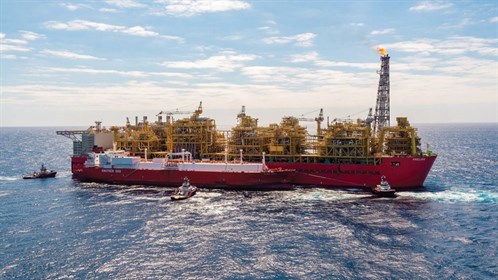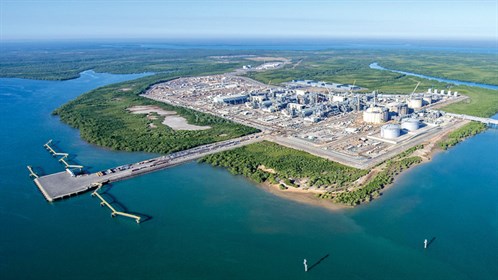Regional Focus: Australia to boost LNG exports despite domestic gas shortage
Australia is planning further increases in LNG production and exports over the next decade, despite quickly depleting reserves and a looming supply shortage in the domestic market.
In recent years, supplies of Australian LNG to global markets have increased sharply, from 27.6 MMt (38.1 Bm3) in 2015 to approximately 67 MMt (92.5 Bm3) in 2018. Australia’s LNG producers plan to collectively displace Qatar from its leading position in the global LNG market.
Australia is prepared to increase its LNG export volume to 100 MMt in the short term. This would help meet growing demand from China, which is expected to overtake Japan in the next few years to become the largest buyer of Australian LNG.
Export projects struggle with high costs, gas shortages. Shell’s recently commissioned Prelude floating LNG (FLNG) vessel (Fig. 1), used in the Prelude and Concerto gas fields in the Browse basin 200 km off the coast of Australia, produces 3.6 MMtpy of LNG, 1.3 MMtpy of condensate and 400,000 tpy of LPG.
 |
|
Fig. 1. Prelude FLNG is the world’s largest offshore facility ever constructed. |
According to analysts, production from Prelude and other FLNG vessels may lead to a worldwide decrease in the cost of LNG supplies and raise the competitiveness of LNG in comparison to other energy sources.
However, Australia’s massive LNG projects, including Prelude, have been fraught with cost overruns. In some cases, this has caused—or is predicted to cause—delays in the startups of some LNG projects. An example of this is the Ichthys LNG project (Fig. 2), which involves the development of the Ichthys gas field off the northwestern coast of Australia, in the Timor Sea. Among the stakeholders of Ichthys LNG are Inpex Corp. in partnership with Total, Tokyo Gas, Osaka Gas and Chubu Electric Power.
 |
|
Fig. 2. The IchthysLNG development off the northwestern coast of Australia has seen massive cost overruns. |
Over the past few years, the cost of the Ichthys project has more than doubled from $20 B to $45 B. This led Total to reduce its share from 30% to 26% at the end of 2018. Similar situations have been observed with other Australian LNG projects for which costs have significantly increased in recent years.
At the same time, Australia’s competition with Qatar in the LNG sector has caused gas prices for consumers on the east coast to almost double. The majority of Australia’s gas is located on the west coast of the country, making it too expensive to build pipelines to transport supplies to the east.
A recent forecast from independent research group EnergyQuest predicts another doubling of prices by 2028. The large number of long-term export contracts between Australian LNG suppliers and foreign buyers has further impacted domestic gas volumes and prices.
A complex situation is observed in the large Australian state of Victoria, located in the southeast. According to the Australian Competition and Consumer Commission and the Australian Energy Market Operator, Victoria may face a full-scale gas shortage by mid-2021. At present, Victoria is the largest consumer of gas in Australia. Possible shortages could pose serious threats to the energy security of the entire country.
Most of the gas is supplied to Victoria from Gippsland Basin, which is home to Australia’s largest oil and gas fields. Most of the fields are jointly developed by ExxonMobil and BHP Billiton through a JV. These offshore fields have provided Australia with cheap gas since 1969 and supplied about one-fifth of Australia’s east coast gas demand in recent years. However, these fields likely will be unable to meet demand volumes going forward, due to the ongoing depletion of their reserves. ExxonMobil has even considered importing LNG to Australia in a move to overcome gas shortages and protect its market share.
Australia: The next LNG importer? Despite its status as one of the world’s leading LNG exporters, Australia may soon enter the list of major importers. The re-orientation of export-focused LNG plants already in operation will not be financially feasible or supported by their investors. Australia may be forced to begin construction of large LNG import terminals near major seaports in New South Wales, Victoria and South Australia. LNG imports could come to Australia from the U.S. and Middle East.
Analyst predict further deterioration of Australia’s LNG sector, as the growing domestic supply shortage may prompt the government to force LNG exporters to break long-term contracts with their Chinese, Korean and Japanese customers. The overestimation of resources is a key factor. Queensland could be forced to shut down one-third of its US$59-B (A$84-B) LNG production volume because gas supplies are predicted to run out faster than initially expected.
In 2018, the government approved a gas security mechanism allowing it to force LNG producers to limit exports in the event of a domestic shortage. This security mechanism has not yet been enforced, but the policy raises critical questions about sovereign risk and the future of Australia’s multi-billion-dollar LNG industry. GP
Eugene Gerden is an international contributing writer specializing in the global oil refining and gas industry. He has been published in a number of prominent industry publications.




Comments